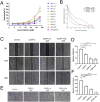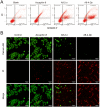Design, synthesis and antitumor activity of Ascaphin-8 derived stapled peptides based on halogen-sulfhydryl click chemical reactions
- PMID: 37409042
- PMCID: PMC10318414
- DOI: 10.1039/d3ra02743k
Design, synthesis and antitumor activity of Ascaphin-8 derived stapled peptides based on halogen-sulfhydryl click chemical reactions
Abstract
Ascaphin-8 (GFKDLLKGAAKALVKTVLF-NH2), isolated from the norepinephrine-stimulated skin secretion of the North American-tailed frog Ascaphus truei, is a C-terminal α-helical antimicrobial peptide with potential antitumor activity. However, linear peptides are difficult to be applied directly as drugs because of their inherent defects, such as low hydrolytic enzyme tolerance and poor structural stability. In this study, we designed and synthesized a series of stapled peptides based on Ascaphin-8 via thiol-halogen click chemistry. Most of the stapled peptide derivatives showed enhanced antitumor activity. Among them, A8-2-o and A8-4-Dp had the most improved structural stability, stronger hydrolytic enzyme tolerance and highest biological activity. This research may provide a reference for the stapled modification of other similar natural antimicrobial peptides.
This journal is © The Royal Society of Chemistry.
Conflict of interest statement
The authors declare that they have no known competing financial interests or personal relationships that could have appeared to influence the work reported in this paper.
Figures





Similar articles
-
Design, synthesis, and biological evaluation of stapled ascaphin-8 peptides.Bioorg Med Chem. 2021 Jun 15;40:116158. doi: 10.1016/j.bmc.2021.116158. Epub 2021 Apr 22. Bioorg Med Chem. 2021. PMID: 33932712
-
Peptidomic analysis of skin secretions supports separate species status for the tailed frogs, Ascaphus truei and Ascaphus montanus.Comp Biochem Physiol Part D Genomics Proteomics. 2007 Jun;2(2):121-5. doi: 10.1016/j.cbd.2007.01.003. Epub 2007 Jan 30. Comp Biochem Physiol Part D Genomics Proteomics. 2007. PMID: 20483285
-
The ascaphins: a family of antimicrobial peptides from the skin secretions of the most primitive extant frog, Ascaphus truei.Biochem Biophys Res Commun. 2004 Jul 16;320(1):170-5. doi: 10.1016/j.bbrc.2004.05.141. Biochem Biophys Res Commun. 2004. PMID: 15207717
-
Antimicrobial peptides from the skins of North American frogs.Biochim Biophys Acta. 2009 Aug;1788(8):1556-63. doi: 10.1016/j.bbamem.2008.09.018. Epub 2008 Oct 17. Biochim Biophys Acta. 2009. PMID: 18983817 Review.
-
Rational design of stapled antimicrobial peptides.Amino Acids. 2023 Apr;55(4):421-442. doi: 10.1007/s00726-023-03245-w. Epub 2023 Feb 12. Amino Acids. 2023. PMID: 36781451 Review.
References
LinkOut - more resources
Full Text Sources

